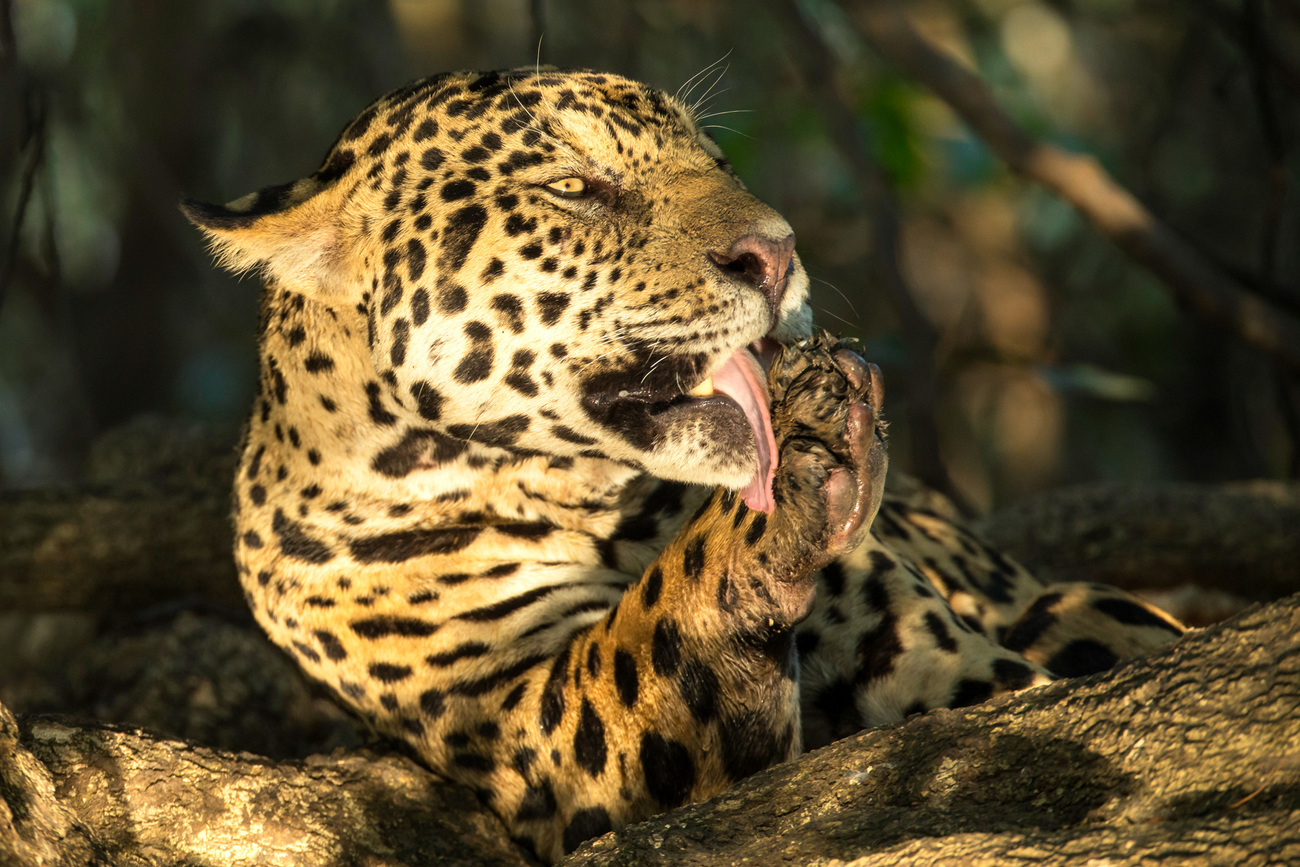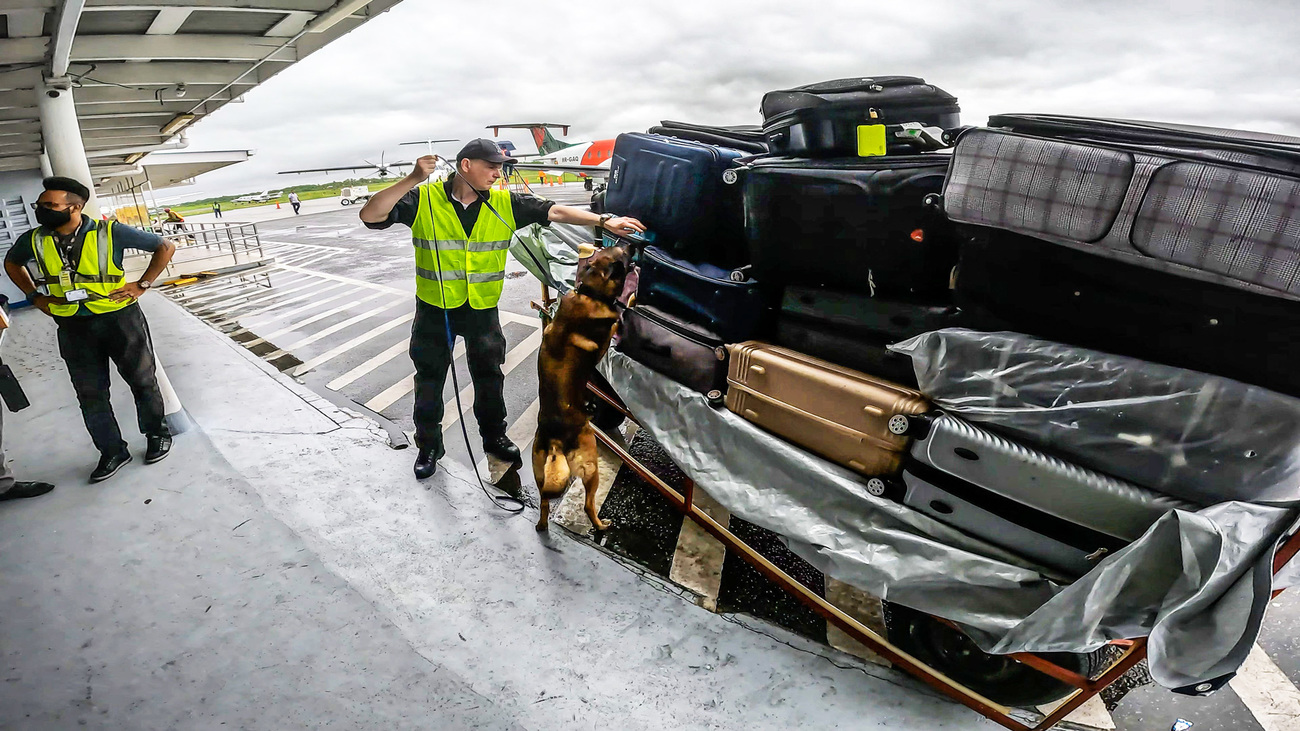Operation Jaguar - South America
To protect jaguars in the Americas, we are helping to fight the growing threat of illegal wildlife tradeprotecting the jaguar, the largest big cat in the Americas
protecting the jaguar, the largest big cat in the Americas

The jaguar is one of the five big cats in the genus Panthera, which also includes tigers, lions, leopards and snow leopard. Living in the tropical rainforests and wetlands of the Americas, the mighty jaguar is the largest cat species in the region.
Unfortunately, the jaguar population across the Americas keeps shrinking. They are losing habitat at an alarming rate due to deforestation, and they are increasingly threatened by poaching.
That is why, from 2019 to 2022, IUCN NL, Earth League International (ELI) and IFAW worked together on Operation Jaguar to combat illegal trade in jaguars in Peru, Bolivia, Guyana and Suriname. The project was made possible by support from the Dutch Postcode Lottery.
deforestation and poaching threaten the jaguar
For centuries, the jaguar has been revered as a symbol of power and strength by Indigenous peoples and local communities. As a top predator, it also plays an important role to in the wider ecosystem by balancing the food chain and helping to control the populations of other species.
Unfortunately, their population is declining, with scientists estimating that only 130,000–208,000 jaguars remain in the wild across the Americas. They are losing habitat due to deforestation and new infrastructure for urban development. This affects their ability to roam freely to find prey and mates.
The jaguar is also increasingly poached for its fangs, skin, bones and other body parts. In some cultures, the bones are thought to have medicinal benefits and the fangs are used for jewelry to signify social status. Seizure data show a significant rise in jaguar trafficking since 2012, and jaguar body parts and products are now being sold more openly, particularly on online platforms.
research into transnational trafficking networks
As part of Operation Jaguar, ELI conducted research investigations on jaguar trafficking in Latin America and the Caribbean. Through its intelligence-gathering operations, ELI researched the illegal wildlife supply chain to help unveil the dynamics of jaguar trafficking in the region and identify the main players, trafficking routes and destinations.
Some of those destinations are national and regional markets in South America. Other destinations are international markets, such as Asia. At IFAW, we work closely together with authorities in China to combat illegal wildlife trade. Over the years, Chinese authorities have strengthened legislation regarding wildlife trade, increased national and transboundary enforcement efforts and run awareness-raising campaigns on the importance of protecting wildlife in key public transport areas such as trains, metros and airports.
In 2020, ELI published a report after conducting investigations in Bolivia, unveiling traffickers’ modus operandi and transport methods, routes and geographical hotspots. As a result, in 2021, Bolivian authorities proceeded to arrest five of South America’s top jaguar traffickers.
Key findings from ELI’s research investigations are summarized in a new report that was shared during the 19th Conference of the Parties (CoP) to the Convention on the International Trade in Endangered Species of Wild Fauna and Flora (CITES) in Panama in November 2022. The report includes regional case studies of top transnational jaguar trafficking networks identified through the investigative work. It also highlights the overlap between jaguar trafficking and other serious crimes, such as drug smuggling, human trafficking, gold trafficking or money laundering. The full report will be released in 2023.
advocating for increased protection
The jaguar is listed in the IUCN Red List as Near Threatened. It is therefore critical to prioritize the protection of jaguars and their habitats, and for governance and law enforcement to implement stricter measures to control the trafficking of this species.
In February 2020, there was a big win for jaguars at the 13th CoP of the UN Convention on the Conservation of Migratory Species of Wild Animals in Gandhinagar, India, as governments approved listing the species for the first time to protect the jaguar across its entire range. IFAW’s support was key in getting the big cat included on Appendices I and II, which means that member countries are now committed to assuring that jaguar habitat and migration corridors remain protected.
In addition, through the adoption of Motion 106—Continental conservation priority for the jaguar (Panthera onca)—at the IUCN World Conservation Congress in Marseille in September 2021, international attention was given to the predicament of the jaguar, which will hopefully result in a sense of urgency that will result in action for its protection.
empowering law enforcement and judiciary
IFAW has decades of experience in building capacity of law enforcement officers by empowering them through tailored train-the-trainer workshops, on-the-job mentorship and working with prosecutors and judges to ensure adequate follow up of criminal cases.
As part of Operation Jaguar, IFAW worked with law enforcement officers, customs agents, public prosecutors and judges across Guyana, Peru and Suriname to improve their capacities to better detect, investigate and prosecute wildlife crime. Several trainings and workshops were organized in each country, where participants learned how to identify common species traded in the region, check if wildlife trading permits are legitimate, detect smuggled wildlife and uphold protocols for the management and welfare of seized animals. The trainings also covered critical skills such as investigative strategies, evidence collection and interviewing and working with witnesses.
To further aid law enforcement agencies, IFAW and IUCN NL ran a pilot with Scent Imprint Conservation Dogs to show authorities how detection dogs can help them detect wildlife specimens at seaports and airports. Wesley Visscher trained his dogs Bruce and Boris to use their superb sense of smell to detect jaguar parts in boxes, packages, cars and containers. Since then, other successful pilot sessions have taken place in two of the project countries, motivating local authorities to consider expanding their resources with trained detection dogs specifically to help combat wildlife trafficking.

key role for local and Indigenous communities
Since more than half of world’s biodiversity lies in Indigenous territories, it is crucial to consult and integrate local Indigenous Peoples’ narratives and ecological knowledge to successfully protect ecosystems and cultural diversity. Operation Jaguar acknowledges and understands the key role local communities and organizations play in combatting wildlife trafficking.
IUCN NL worked with SAVIA, a local organization in Bolivia, to organize environmental education and awareness raising activities on the importance of protecting the jaguar. In Suriname, IUCN NL worked with researchers like Vanessa Kadosoe from Neowild, who conducts research on the behavior of and the threats to jaguar populations through various methods, such as monitoring them with camera traps.
In October 2021, experts and partners of Operation Jaguar spoke about the importance of including local and indigenous views on jaguar conservation at a major interdisciplinary conference on anthropology and conservation hosted virtually by the Royal Anthropological Institute.
To help spread the message on the need to protect jaguars and curb illegal wildlife trade to the wider public, Operation Jaguar supported the production of Tigre Gente, a documentary by filmmaker and National Geographic Explorer Elizabeth Unger that has been featured in international film festivals.
next steps for jaguar protection
All activities as part of Operation Jaguar have been geared towards increasing knowledge exchange and collaboration within and between South American countries. Whether through gathering information, enhancing law enforcement, or raising awareness among the public, Operation Jaguar has provided vital skills and resources to empower local agencies, organizations, and communities to help save the iconic jaguar and secure its natural and cultural legacy to the Americas.
To ensure continuation of the efforts to combat trafficking in jaguars, all countries have developed or are in the process of developing action plans and strategies for jaguar conservation. IFAW worked closely with the Surinamese government to develop the Suriname Jaguar Species Action Plan (SAP), which was finalized in October 2022. Suriname’s overall vision is to conserve viable populations of jaguars across the country. The plan details several conservation strategies, which include actions targeting the international demand for wildlife, managing human-wildlife conflict and supporting law enforcement. To help Guyana further develop their jaguar action plan, IFAW has committed to carry out further trainings for prosecutors and judges in 2023, as both the needs assessment in 2019 and the government identified this as a priority.
Even though the project has ended, IUCN NL, ELI and IFAW will continue to collaborate with each other and local partners for the common goal to ensure long-term protection and survival of jaguars.
Related content
Every problem has a solution, every solution needs support.
The problems we face are urgent, complicated, and resistant to change. Real solutions demand creativity, hard work, and involvement from people like you.